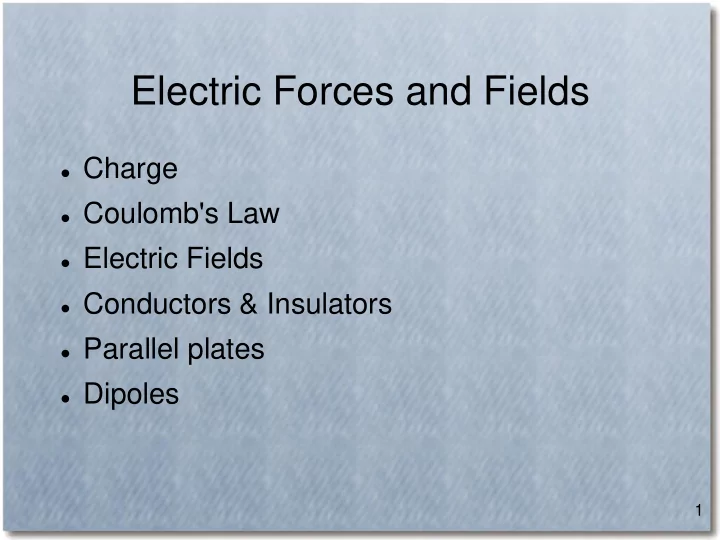

Electric Forces and Fields Charge Coulomb's Law Electric Fields Conductors & Insulators Parallel plates Dipoles 1
Friction causes these effects Pollen sticks to bees Dust sticks to TV Static cling of clothes Shocks touching metal door handles Sparks stroking cats Friction is producing some type of force 2
Experimental evidence has lead to the Electric Charge Model • Friction between objects can cause charge to be added or lost • Charge has two kinds - Positive and Negative • Charges exert force – like charges repel – opposite attract • The force acts over a distance (non-contact) • Neutral objects have an equal mixture of +ve and -ve charges 3
What is charge ? • Basic property of matter • Carried by Electrons (-ve) and Protons (+ve) 4
Insulators • Electrons cannot move through the material • Electrons can be removed or added by friction • Examples – Glass, Plastic 5
Conductors Electrons are free to move through the material Example – metals, graphite 6
Charge Induction • Separation of charge by the influence of an electric field • Action over a distance • Charges can be induced on insulators and conductors 7
Charge Induction in Conductors A charged object can induce a charge in a conductor The separation of charges is called charge polarization Causes an attractive polarization force 8
Charge Induction in Insulators • An external charge displaces the electron cloud around an atom • Causes a net attractive force • Creates an electric dipole - equal charges separated by small distance 9
Electric Charge Model (contd.) • Two types of material – Conductors – charge moves easily through Insulators – charges are stuck – • Charge is conserved – just like Energy and Momentum • Charge is quantized – it comes in multiples of small units (-1.6x10 - 19 Coulombs) 10
What is the Electric Force ? One of the fundamental forces of nature (like gravity) Like charges repel, unlike charges attract Proportional to amount of electric charge Decreases with distance between charges Strength and direction are quantified by Coulomb's Law 11
Coulomb's Law • The force between two charged bodies Q Q 1 2 F = K 12 2 r 12 F 12 is the force between two charges, Q 1 and Q 2 , separated by a distance r 12 . K is the Electrostatic Constant (9.0x10 9 Nm 2 /C 2 ) 12
cf. Newton's Law of Universal Gravitation • The force between two massive bodies M M 1 2 F = G 12 2 r 12 F 12 is the force between two masses, M 1 and M 2 , separated by a distance r 12 . G is the Gravitational Constant (6.67x10 -11 Nm 2 /kg 2 ) 13
What is an Electric Field ? It is a concept used to describe how electric forces will act on a charged particle in space. 14
More on Electric Field lines Lines follow the path of a freely moving positive charge Originate at positive charges Terminate at negative charges 15
Even more on electric fields • Higher density of lines means higher field • Field lines cannot cross 16
Pictures of electric fields Unlike charges attract Like charges repel 17
Electric Field, E , Strength and Direction Defined as the force on a positive unit charge, or force per unit charge. Units are Newtons per Coulomb (N/C) F 1 Qq Q Q E E = = K = K K 2 2 q q r r 2 r F q E 18
Electrostatic fields are vectors • The overall field on q C can be calculated using vector addtition: q C Field due to q A + + q A Field due to q B Total field on q C - q B 19
Electric field between “Infinite” parallel plates in a vacuum Very large plates each with charges +Q and - Q, with a small gap relative to the area of the plates 20
Electric field between “Infinite” parallel plates in a vacuum Q Q 4 E = K = ε A A 0 Epsilon Ɛ 0 is the permittivity constant 8.85x10 -12 Nm 2 /C 2 for a vacuum Note: The Electric field is independent of the distance between the plates 21
Conductors and Electric Fields Charge moves freely within conductors The excess charges will repel each other to reach a stable equilibrium The charges collect at the surface of the object, and spread out. Charges move so that the field lines are always perpendicular to the surface of the conductor 22
Electric Field inside conductors Any charge inside a conductor would move to cancel out any electric field The electric field inside a conductor is therefore always ZERO after it has reached electrostatic equilibrium 23
Are charges spread evenly on the surface of a conductor? Not necessarily Depends on the shape Tend to accumulate near the “pointy” ends. 24
Conductors inside Electric Fields The charges inside a conductor in an electric field will flow to reach static equilibrium – until the field inside the conductor is ZERO. Called a Faraday cage 25
Example Faraday cages • Microwave ovens • Antistatic bags for computer memory • Shields on co-axial cable 26
Summary Charge is a fundamental property of matter Charges exert forces described by Coulomb's law Electric Fields are used to describe the forces on a unit electric charge in space Charge flows to cancel out the field inside conductors 27
Homework • Knight PROBLEMS page 681 • 52, 53, 56, 57, 58, 60, 63, 64. 28
Recommend
More recommend